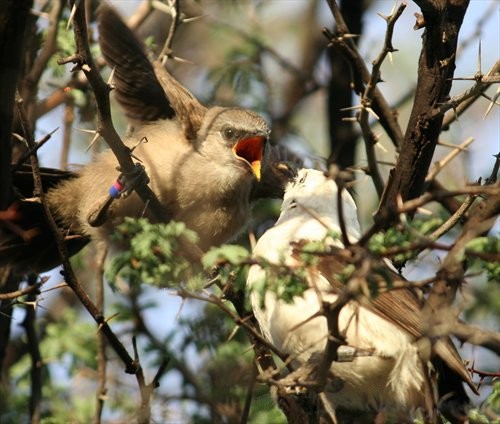Southern Pied Babbler
A species of Turdoides Scientific name : Turdoides bicolor Genus : Turdoides
Southern Pied Babbler, A species of Turdoides
Botanical name: Turdoides bicolor
Genus: Turdoides
Content
Description General Info
 Photo By Alex Thompson , used under CC-BY-SA-3.0 /Cropped and compressed from original
Photo By Alex Thompson , used under CC-BY-SA-3.0 /Cropped and compressed from original Description
The southern pied babbler is a medium-sized 75 to 95 grams (2.6 to 3.4 oz) cooperatively breeding passerine bird. Groups range in size from 2-16 adults, but pairs are rare. The species is sexually monomorphic, with males and females indistinguishable from physical characteristics. Each group comprises a dominant breeding pair that monopolise access to breeding opportunities. Recent genetic research has confirmed that these dominant pairs are responsible for more than 95% of young hatched. Occasional mixed parentage has been observed, but is predictable in most cases: subordinates primarily gain parentage when a new (unrelated) immigrant disperses into the group, or a new group is founded. All group members cooperate to help raise the young hatched from a single clutch. Clutch size varies between two and five, with a modal clutch size of three. Cooperative behaviours include: provisioning young (both in the nest and post-fledging), sentinel behaviour, territory border defense, teaching behaviour and babysitting behaviour (where semi-independent fledglings follow adults between foraging sites and away from predators). The breeding season extends from late-September to early April, although this varies between years and is strongly rain-dependent. Groups can raise up to three successful clutches per breeding season. Average incubation time is 14 days, and average time between hatching and fledging is 16 days. Fledging time varies according to group size: small groups tend to fledge their young earlier than large groups. Post-fledging, young are poorly mobile, unable to fly, and rely entirely on adult group members for food. Fledgling foraging efficiency develops slowly, and fledglings can continue to be provisioned by adults for up to four months post-fledging. The amount of care that young receive during this stage has long-term effects: fledglings that receive care for the longest periods tend to be heavier and better foragers than their counterparts. In addition, they are more likely to successfully disperse from their natal group and consequently begin reproducing earlier than their “failed-disperser” counterparts. 
Size
25 cm
Nest Placement
Shrub
Feeding Habits
Southern Pied Babbler primarily feeds on insects like beetles, caterpillars, ants, and also small reptiles and amphibians. Southern Pied Babbler forages on the ground, examining debris and soil, and may sometimes pick food from dung or carrion. They forage in groups, often with other bird species, and use their bills to stab prey.
Habitat
The southern Pied Babbler primarily inhabits semi-arid to arid savannas, thriving in areas with a mix of corkwood, acacia, and a light covering of grass. This species prefers environments with thornveld, dry broadleaf woodlands, and bushy undergrowth along rivers. Characteristically, the southern Pied Babbler is associated with habitats having low blackthorn and taller camelthorn woodlands, as well as regions invaded by exotic mesquite.
Dite type
Omnivorous
General Info
Feeding Habits
Bird food type
Behavior
Aggression toward fledglings is most commonly observed when the dominant pair have begun to incubate another brood. During this period, begging fledglings will be punished by parents using aggressive behaviour such as jumping on the youngster. In all cases, fledglings stop begging immediately following attack. Brood overlap results in a distinctive division of labour, with subordinate adults continuing to care for fledglings while the dominant pair concentrate their effort on the new brood. Owing to the extended period of post-fledging care in this species, this can result in dependent young from multiple broods being raised simultaneously. Pied babblers are strongly territorial, and defend their borders using wing and vocal displays on a near daily basis. These fights rarely lead to physical aggression and injury from such fights is very rare. Groups defend the same territory year-round and small groups tend to lose portions of their territory to larger neighbouring groups. Research on pied babblers has provided the first evidence of teaching behaviour in an avian species. Pied babblers teach their young by giving a specific purr call each time they deliver food. Young learn to associate this call with food and reach out of the nest each time they hear it. Adults exploit this association to encourage young to fledge by giving the purr call at a distance from the nest, enticing young to follow them. Post-fledging, adults continue to use the call to encourage young to move between foraging areas or away from predators. This call is also used to recruit independent fledglings to a rich foraging site, and may thus provide young with information on where to forage to locate rich food sources. Research on pied babblers has also provided evidence of task partitioning behaviour. In this species, the dominant pair are able to leave their dependent young in the care of helpers and initiate a new brood. This allows brood overlap: several broods of dependent young can be raised at the same time. Such a behaviour highlights the benefits of cooperative breeding: many helpers allow breeders to invest in more broods. Parents initiate this task partitioning by aggressively punishing offspring that beg at them for food. This repeated punishment results in young fledglings begging for food from helpers rather than their parents: freeing up their parents to breed again. 
Species Status
Not globally threatened.
Scientific Classification
Phylum
Chordates Class
Birds Order
Perching birds Family
Laughingthrushes Genus
Turdoides Species
Southern Pied Babbler